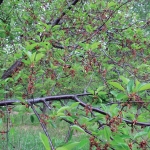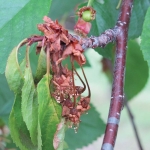Tart cherry growers in Michigan got a surprise last year when European brown rot appeared in their orchards.
“The extent of infection observed in some orchards was surprising on Montmorency,” said Dr. George Sundin, Michigan State University tree fruit pathologist. “It will take growers two to three years of intense activity to reduce inoculum levels in orchards that were affected.”
Overwhelmingly, the U.S. tart cherry industry is dominated by the red-skinned, white-fleshed Montmorency variety. Some growers have diversified, adding the European-type, dark-fleshed, less-sour Balaton variety. Montmorency is more resistant to European brown rot than is Balaton.
Super-optimal conditions
“Balaton was hammered in 2013 by European brown rot,” Sundin said. “It is not usually an issue on Montmorency, so it’s likely that conditions last year were super-optimal for infection.”
Unlike American brown rot (Monilinia fructicola), European brown rot (M. laxa) is not a problem on the fruit—at least under Michigan conditions—but it does attack flowers and spurs. “The lack of fungal sporulation activity closer to harvest is a huge bonus for growers. In Europe, it does go to the fruit,” Sundin said.
“The European brown rot pathogen is very highly sensitive to environmental conditions,” he said.
It takes a wetting event, followed by relative humidity above 80 percent for more than 16 hours for infection to occur. Trees with light freeze damage may be more sensitive to infection, he said. Infection occurs more frequently in orchards that are surrounded by windbreak trees that result in slow drying conditions, and also in low spots and other sites affected by colder temperatures and fog.
The organism can grow and sporulate in cold conditions—temperatures in low 40s—so it is active prior to bloom and then infects flowers, spurs, and shoots, resulting in shoot dieback as well as dead flowers. Last year, the affected orchards had very warm temperatures leading up to bloom, then very cold conditions from white bud through bloom, Sundin said.
Spurs
Both American and European brown rots attack the flowers, but the European brown rot fungus moves through flowers into spurs. That is a key difference between the two, he said.
“In 2014, Indar (fenbuconazole) will be the fungicide of choice in affected orchards,” Sundin said. He recommends a rate of six fluid ounces per acre and two applications, at white bud and seven days later.
Testing of European brown rot isolates for fungicide sensitivity began last fall. Sundin will test Topsin M (thiophanate-methyl), Topsin M plus captan, captan alone, and possibly Vanguard (cyprodinil) for European brown rot control next year in Balaton cherries and hopes to know by spring what growers can use.
For now, they are being advised to prune, remove, and burn dead shoots that were infected last year because these will be the source of inoculum for this year.
“It doesn’t take a ton of overwintering sites to cause infection next year,” he told growers during the tart cherry educational session at the Great Lakes Fruit, Vegetable, and Farm Market Expo in December. •



Leave A Comment